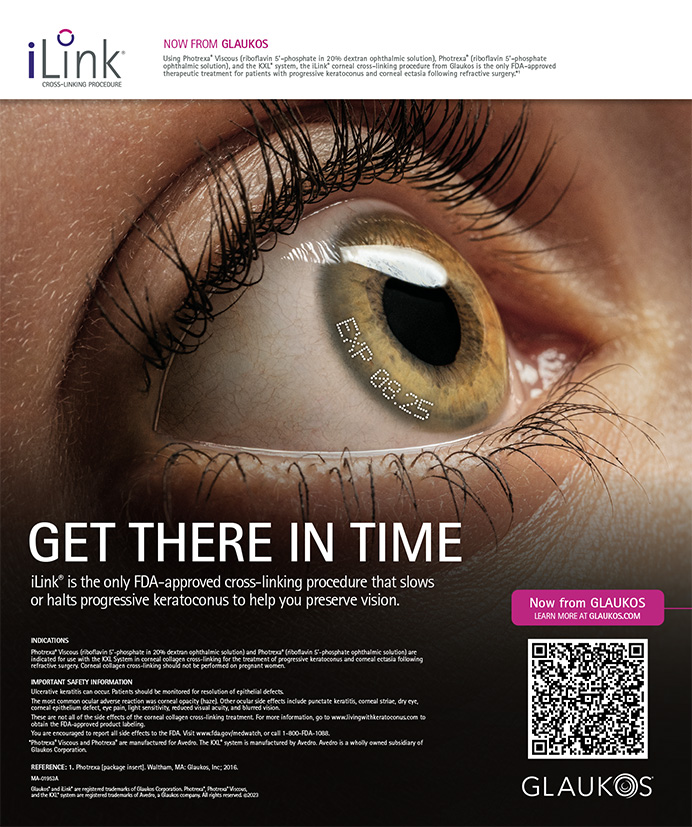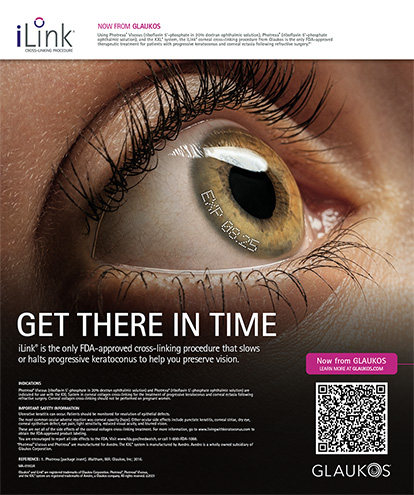CASE PRESENTATION
A local optometrist referred a 52-year-old white female to our institute for vision correction surgery. The patient reported a history of high myopia and esotropia with amblyopia of the left eye. She presented with a spectacle prescription of -33.25 sphere OD, and -30.00 sphere OS. Previously, this patient had been fitted with -25.0 contact lenses and spectacle overcorrection for the residual high myopia. Her visual acuity with her spectacles was 20/200 in each eye. Refraction of -34.0 sphere OD produced 20/60 vision, and -34.50 sphere OS 20/200 (amblyopia). She had 7 D of prism correction base-out OU in a pair of reading glasses she used in addition to her contact lenses. An A-scan biometry revealed axial lengths of 32.76 in each eye. This unusually long axial length was expected considering the extreme myopia, and it was almost a full centimeter longer than the average human eye! The keratometry was steeper than expected, measuring 46.50 X 47.50 in each eye.
The patient's pachymetry revealed a satisfactory corneal thickness of 570 µm in each eye, and her pupils were 5 mm in mesopic illumination. Applanation tensions were normal at 18 mm Hg in each eye. A slit-lamp examination revealed clear lenses and bilateral posterior vitreous detachments. Indirect ophthalmoscopy showed myopic macular degeneration with apparent posterior staphylomata. Although a local retinal specialist had followed the patient's progress, she had not required any prophylactic or therapeutic peripheral retinal laser treatment.
HOW WOULD YOU PROCEED?1. Perform LASIK for -15 D and insert a phakic IOL for the residual myopia?
2. Perform PRK or LASEK for -15 D and insert a phakic IOL for the residual myopia?
3. Insert a phakic IOL for -20 D, with or without a corneal flap, and perform LASIK, LASEK, or PRK to treat the residual myopia?
4. Perform a clear lens replacement, with or without a corneal flap, and perform LASIK, LASEK, or PRK for the residual myopia?
SURGICAL COURSE
One refractive surgical procedure alone was not likely to correct this rare extreme myopia. The patient's corneal thickness and curvature would tolerate an excimer laser procedure, but that alone would not come near to fully correcting the extreme myopia. At the time of this patient's presentation, phakic IOLs were undergoing an FDA study that allowed their use in eyes with up to -20.00 of myopia. Therefore, this patient qualified for the only form of ?bioptics? that could be performed on her eyes in the US, which was clear lens replacement with a subsequent excimer laser procedure.
I explained to the patient that due to her extreme axial length and staphylomata, IOL calculation accuracy would not be predictable, but that a subsequent excimer laser procedure could correct the residual ametropia. Because of the possibility of extreme residual ametropia, I decided to operate on the amblyopic left eye first. An A-scan biometry, using three different formulae, recommended a -10.0 IOL for emmetropia. As this power was not available in foldable material, a PMMA IOL had to be used.
A corneal flap with a microkeratome in preparation for subsequent LASIK was not performed, as the refractive result from the clear lens replacement might have necessitated PRK or LASEK rather than LASIK. Therefore, for the first stage, I chose to perform a simple clear lens replacement.The procedure was performed under topical anesthesia with nonpreserved intraocular lidocaine 1%. As a longer incision was necessary for the PMMA IOL implantation, I used a superior self-sealing sutureless scleral tunnel incision. I then implanted a P574UV PMMA -10.0 IOL (Bausch & Lomb, Rochester, NY) (Figure 1 and 2). This IOL has a 6-mm biconcave optic diameter and a 13.25-mm overall haptic length. Aside from working in an extremely deep anterior chamber and rather flaccid scleral support, the surgery was routine and uneventful.
OUTCOME
We were anxious to see the initial refractive outcome in this first eye, considering its preoperative spherical equivalent of -34.50. This was the largest and most myopic eye I had ever seen in my 30 years of experience in ophthalmology! We were delighted when the day-1 postoperative spherical equivalent was -2.37! The patient was ecstatic. Her uncorrected vision was 20/100, and uncorrected near vision was J2. The patient's corrected distance vision had improved from 20/200 preoperatively to 20/40 at this day-1 postoperative visit in this amblyopic eye. This was the best visual acuity that this eye had ever had, presumably due to the difference between her extreme image minification with her spectacle correction preoperatively, compared to the image magnification now provided by the IOL. After discussion with the patient regarding bioptic options, and in view of the refractive result in the first eye, we decided to proceed with clear lens replacement in the second eye before considering second-stage bioptic corneal laser surgery.
Two weeks later, the second eye underwent uneventful clear lens replacement with implantation of a P574UV -12.0 PMMA IOL (Bausch & Lomb). The next day, this “nonamblyopic” eye had a spherical equivalent of -1.37. The patient's uncorrected distance vision was 20/60, and the corrected distance vision was 20/40. Again, she and I discussed the options of corneal refractive surgery for her residual myopia, including LASIK, LASEK, PRK, and mini-RK, including monovision, but she declined any form of bioptic enhancement, preferring her new uncorrected vision for near tasks. Although -2.37 and -1.37 would be unacceptable for most people with “normal” vision who are correctable optically or surgically to 20/20, 20/40 seemed like a “miracle” to this patient. She was returned to her referring optometrist for new distance spectacle/contact lens correction and to her retina specialist for continued periodic follow-up.
Harry B. Grabow, MD, is Founder and Director of the Sarasota Cataract & Laser Institute, Center for Advanced Eye Surgery, Sarasota, Florida, and Clinical Assistant Professor, University of South Florida, Tampa, Florida. He does not hold a financial interest in any of the materials herein. Dr. Grabow may be reached at (941) 921-7744; harry@grabow.com

